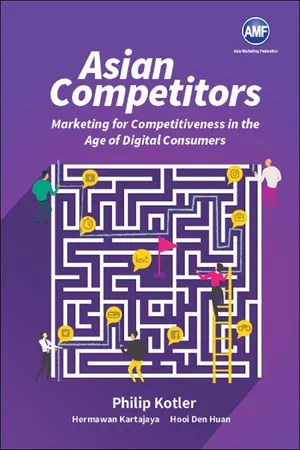
Asian Competitors
Marketing for Competitiveness in the Age of Digital Consumers
- 344 pages
- English
- ePUB (mobile friendly)
- Available on iOS & Android
Asian Competitors
Marketing for Competitiveness in the Age of Digital Consumers
About this book
Today's dynamic and uncertain environment has contributed to the changing nature of markets. In order for companies to keep up, they will need to embark on new wave marketing to ride the wave of opportunities provided by the changes in the environment, such as the digital revolution.
This is critical all over the world, but none more so than in Asia. Asia is not only the world's biggest market, but also the fastest growing. It is therefore essential for marketers to understand the dynamics of Asian companies and what they have to offer to the wider world. This book analyzes competitive companies from 18 Asian countries that have successfully practiced new wave marketing and in so doing, provide invaluable lessons that others may find useful. Comprehensive case studies are used not only to describe how some of Asia's best companies compete, but also to analyze the concepts of new wave marketing their actions are based on. This book is unique in its depth and breadth of cases, from companies in the ASEAN region to North-east Asia, including Mongolia and SAARC.
The authors of this book, Professor Philip Kotler, arguably the Father of Modern Marketing, Hermawan Kartajaya from Indonesia, and Hooi Den Huan from Singapore, are all experts in their field and have previously produced other bestsellers. This book, with its focus on real life examples of competitive Asian companies in the age of digitalization, complements the principles and theoretical frameworks of new wave marketing that are detailed in its sister book, Marketing for Competitiveness. Together, these books provide a comprehensive picture of the changing Asian marketing landscape.
Contents:
- Marketing is Transforming?:
- Product-Centric Perspective: Connectivity in Product Development
- Customer-Centric Perspective: Connecting with Digital Consumers
- Human-Centric Perspective: Doing Good by Doing Well in the Connected World
- Marketing 4.0: Moving from Traditional to Digital
- Marketing is Creating?:
- Marketing Strategies for Value Exploration
- Marketing Tactics for Value Engagement
- Marketing Values for Excellent Execution
- Glorecalization Mindset:
- Asia's Local Champions
- Asia's Regional Players: Asia Vision, Local Action
- Asia's Multinational Companies: Global Value, Regional Strategy, Local Tactic
Readership: Marketing practitioners, business professionals, students and academics studying marketing, and general public interested in marketing.Asian Competitors;Asian Consumers;Asia;Digital Consumers;Digitization;Digitalization;New Wave Marketing;Marketing;Fourth Industrian Revolution;Changing Environment;Changing Landscape0 Key Features:
- This case book is unique in that it not only describes how some of Asia's best companies compete, but also analyses how they do so, based on concepts drawn from new wave marketing
- The depth and breadth of the cases is useful for readers to have a good understanding of competitive Asian companies from not only ASEAN but also from North-east Asia, including Mongolia and SAARC
Frequently asked questions
- Essential is ideal for learners and professionals who enjoy exploring a wide range of subjects. Access the Essential Library with 800,000+ trusted titles and best-sellers across business, personal growth, and the humanities. Includes unlimited reading time and Standard Read Aloud voice.
- Complete: Perfect for advanced learners and researchers needing full, unrestricted access. Unlock 1.4M+ books across hundreds of subjects, including academic and specialized titles. The Complete Plan also includes advanced features like Premium Read Aloud and Research Assistant.
Please note we cannot support devices running on iOS 13 and Android 7 or earlier. Learn more about using the app.
Hyundai Motor Company
A Brief Company History
| Year | Events |
|---|---|
| 1967 | Hyundai Motor Company was incorporated |
| 1968 | Began mass production of Cortina |
| 1976 | Launched the first Korean passenger car Hyundai Pony |
| 1983 | The Canadian subsidiary HMC was incorporated |
| 1985 |
|
| 1986 | Launched the large-sized luxury car Grandeur (Azera) |
| 1988 | Launched the mid-sized luxury sedan Sonata |
| 1990 | Launched Elantra and Scoupe |
| 1991 |
|
| 1993 | Launched Sonata II |
| 1994 |
|
| 1995 | Established Hyundai Motor Europe Technical Center (HMETC) |
| 1996 |
|
| 1997 |
|
| 1998 |
|
Table of contents
- Cover
- Title page
- Copyright
- Acknowledgements
- Dedication
- About the Authors
- List of Organisations
- Contents
- Preface
- Part I: Marketing is Transforming?
- Part II: Marketing is Creating?
- Part III: Glorecalization Mindset
- Index